check engine light TOYOTA COROLLA 2020 Owners Manual (in English)
[x] Cancel search | Manufacturer: TOYOTA, Model Year: 2020, Model line: COROLLA, Model: TOYOTA COROLLA 2020Pages: 588, PDF Size: 13.49 MB
Page 5 of 588

5TABLE OF CONTENTS
COROLLA_U
1
2
3
4
5
6
7
8
9
10
Engine compartment .......... 436
Tires ................................... 444
Tire inflation pressure......... 453
Wheels ............................... 455
Air conditioning filter ........... 457
Wireless remote control/elec- tronic key battery.............. 458
Checking and replacing fuses ......................................... 461
Light bulbs .......................... 464
8-1. Essential information Emergency flashers ........... 472
If your vehicle has to be stopped in an emergency .............. 472
If the vehicle is trapped in rising water ................................ 474
8-2. Steps to take in an emergency If your vehicle needs to be towed......................................... 475
If you think something is wrong ......................................... 479
Fuel pump shut off system ......................................... 480
If a warning light turns on or a warning buzzer sounds .... 481
If a warning message is dis- played .............................. 490
If you have a flat tire (vehicles without spare tire) ............ 493
If you have a flat tire (vehicles with a spare tire) .............. 503
If the engine will not start ... 511
If you lose your keys .......... 513
If the electronic key does not operate properly ............... 513
If the vehicle battery is dis- charged ............................ 515
If your vehicle overheats .... 519If the vehicle becomes stuck
......................................... 521
9-1. Specifications Maintenance data (fuel, oil level, etc.) .................................. 524
Fuel information ................. 535
Tire information .................. 537
9-2. Customization Customizable features ....... 548
9-3. Initialization Items to initialize ................ 556
10-1. For owners Reporting safety defects for U.S. owners ............................. 558
Seat belt instructions for Cana- dian owners (in French) ... 558
SRS airbag instructions for Canadian owners (in French)......................................... 560
What to do if... (Troubleshooting) ......................................... 568
Alphabetical Index.............. 571
8When trouble arises
9Vehicle specifications
10For owners
Index
Page 13 of 588
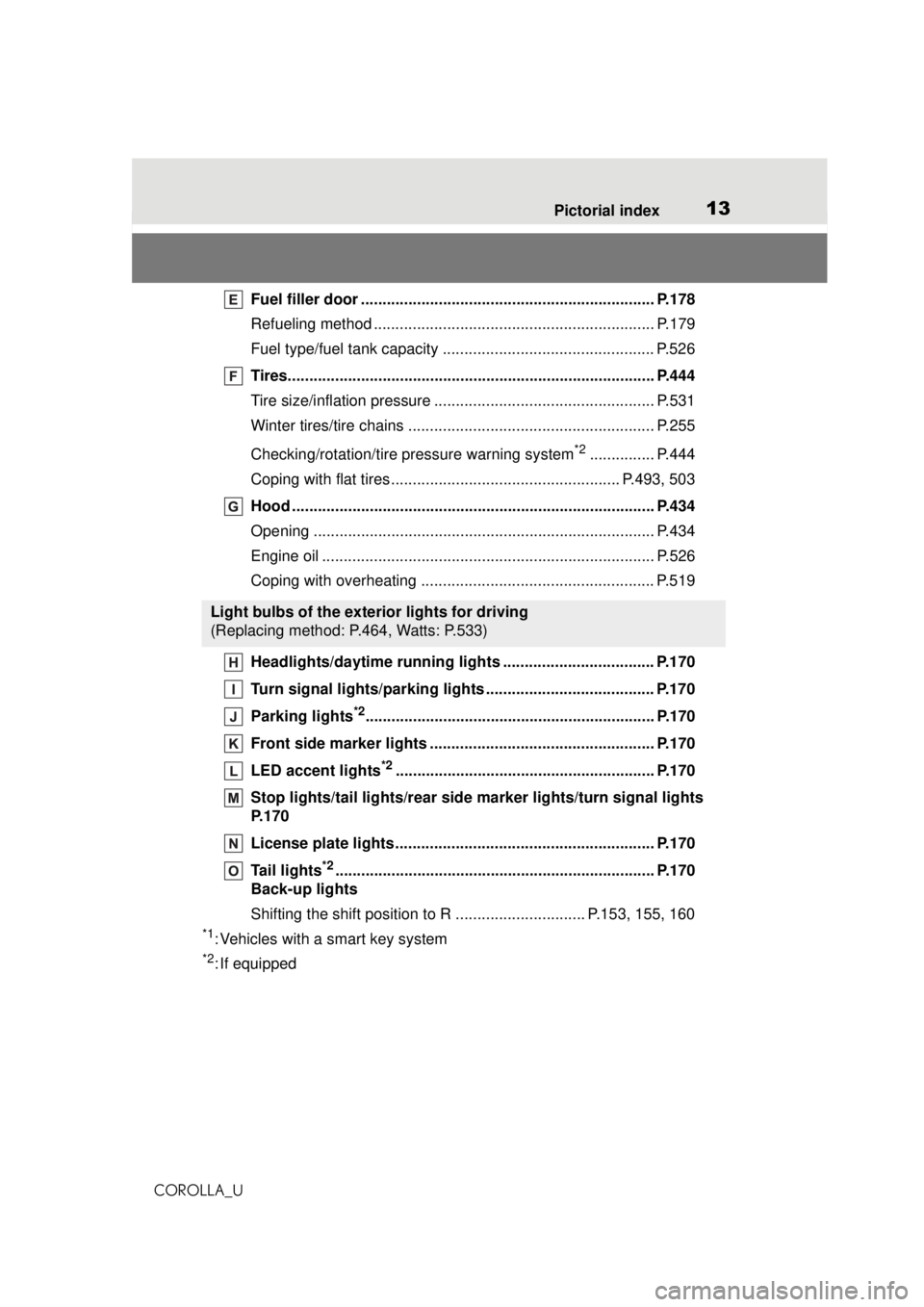
13Pictorial index
COROLLA_U
Fuel filler door .................................................................... P.178
Refueling method ................................................................. P.179
Fuel type/fuel tank capacity ................................................. P.526
Tires..................................................................................... P.444
Tire size/inflation pressure ................................................... P.531
Winter tires/tire chains ......................................................... P.255
Checking/rotation/tire pressure warning system
*2............... P.444
Coping with flat tires..................................................... P.493, 503
Hood .................................................................................... P.434
Opening ............................................................................... P.434
Engine oil ............................................................................. P.526
Coping with overheating ...................................................... P.519
Headlights/daytime running lights ................................... P.170
Turn signal lights/parking lights ....................................... P.170
Parking lights
*2................................................................... P.170
Front side marker lights .................................................... P.170
LED accent lights
*2............................................................ P.170
Stop lights/tail lights/rear side marker lights/turn signal lights
P. 1 7 0
License plate lights............................................................ P.170
Tail lights
*2.......................................................................... P.170
Back-up lights
Shifting the shift position to R .............................. P.153, 155, 160
*1: Vehicles with a smart key system
*2: If equipped
Light bulbs of the exterior lights for driving
(Replacing method: P.464, Watts: P.533)
Page 23 of 588
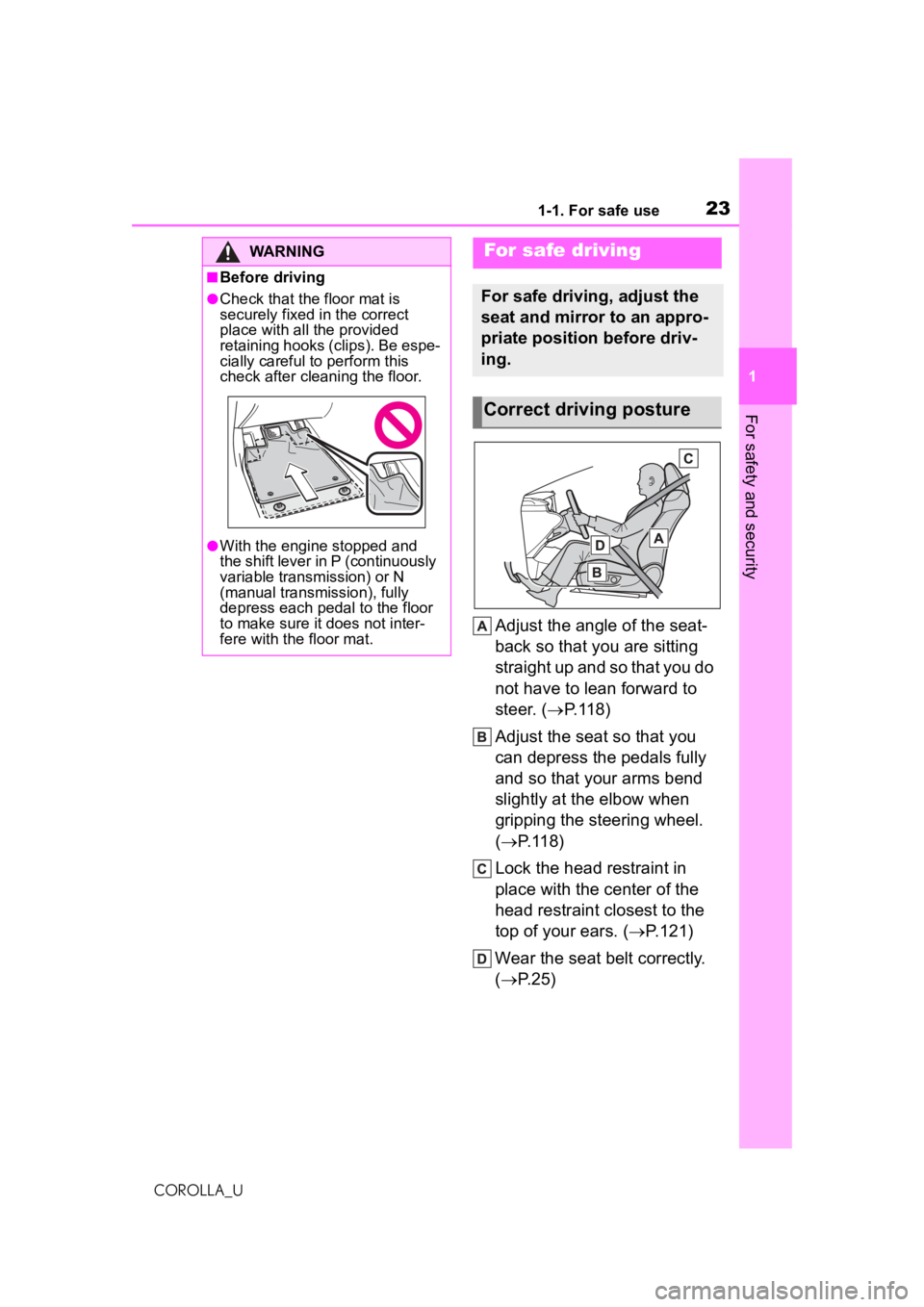
231-1. For safe use
COROLLA_U
1
For safety and security
Adjust the angle of the seat-
back so that you are sitting
straight up and so that you do
not have to lean forward to
steer. ( P.118)
Adjust the seat so that you
can depress the pedals fully
and so that your arms bend
slightly at the elbow when
gripping the steering wheel.
( P.118)
Lock the head restraint in
place with the center of the
head restraint closest to the
top of your ears. ( P.121)
Wear the seat belt correctly.
( P.25)
WARNING
■Before driving
●Check that the floor mat is
securely fixed in the correct
place with all the provided
retaining hooks (c lips). Be espe-
cially careful to perform this
check after cleaning the floor.
●With the engine stopped and
the shift lever in P (continuously
variable transmission) or N
(manual transmission), fully
depress each pedal to the floor
to make sure it does not inter-
fere with the floor mat.
For safe driving
For safe driving, adjust the
seat and mirror to an appro-
priate position before driv-
ing.
Correct driving posture
Page 44 of 588
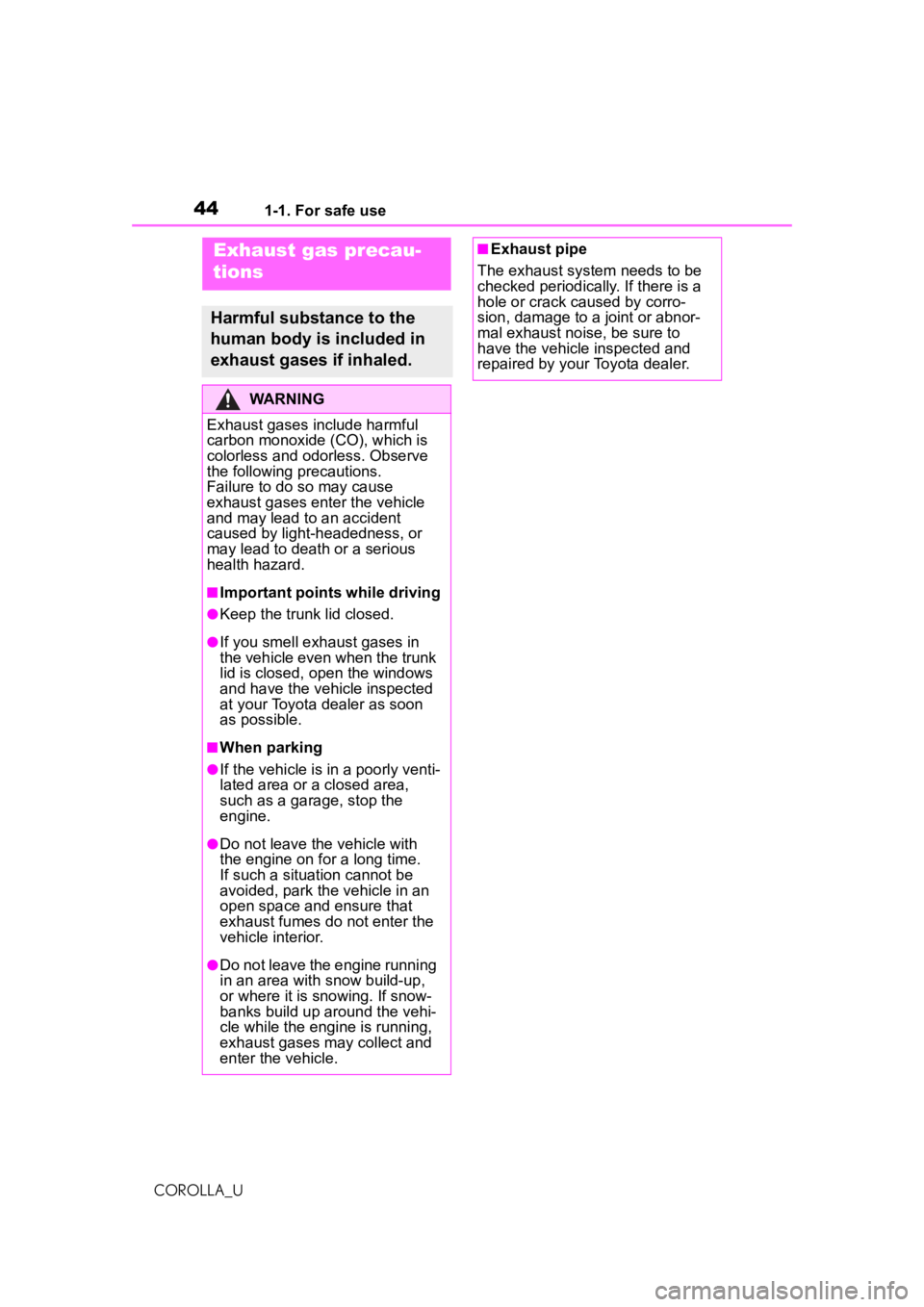
441-1. For safe use
COROLLA_U
Exhaust gas precau-
tions
Harmful substance to the
human body is included in
exhaust gases if inhaled.
WARNING
Exhaust gases include harmful
carbon monoxide (CO), which is
colorless and odorless. Observe
the following precautions.
Failure to do so may cause
exhaust gases enter the vehicle
and may lead to an accident
caused by light-headedness, or
may lead to death or a serious
health hazard.
■Important points while driving
●Keep the trunk lid closed.
●If you smell exhaust gases in
the vehicle even when the trunk
lid is closed, open the windows
and have the vehicle inspected
at your Toyota dealer as soon
as possible.
■When parking
●If the vehicle is in a poorly venti-
lated area or a closed area,
such as a garage, stop the
engine.
●Do not leave the vehicle with
the engine on for a long time.
If such a situation cannot be
avoided, park the vehicle in an
open space and ensure that
exhaust fumes do not enter the
vehicle interior.
●Do not leave the engine running
in an area with snow build-up,
or where it is snowing. If snow-
banks build up around the vehi-
cle while the engine is running,
exhaust gases may collect and
enter the vehicle.
■Exhaust pipe
The exhaust system needs to be
checked periodically. If there is a
hole or crack caused by corro-
sion, damage to a joint or abnor-
mal exhaust noise, be sure to
have the vehicle inspected and
repaired by your Toyota dealer.
Page 74 of 588

742-1. Instrument cluster
COROLLA_U
*1: These lights come on when the engine switch is turned to ON to
indicate that a system check is
being performed. They will turn
off after the engine is started, or
after a few seconds. There may
be a malfunction in a system if
the lights do not come on, or turn
off. Have the vehicle inspected
by your Toyota dealer.
*2: This light illuminates on the multi-information display.
The indicators inform the driver
of the operating state of the
vehicle’s various systems.
Rear passengers’
seat belt reminder
lights ( P.485)
Tire pressure warning
light
*1 (if equipped)
( P.485)
(Orange)
LTA indicator (if equipped)
( P.485)
LDA indicator (if equipped)
( P.485)
(Flashes
or illumi- nates)PCS warning light*1
( P.486)
Slip indicator
*1 ( P.486)
(Flashes)
(U.S.A.)
Parking brake indicator
( P.486)
(Flashes)
(Canada)
Parking brake indicator
( P.486)
(Flashes)
Brake hold operated indi-
cator
*1 (if equipped)
( P.487)
(Orange)
iMT indicator*1 (if
equipped) ( P.487)
WARNING
■If a safety system warning
light does not come on
Should a safety system light such
as the ABS and SRS warning light
not come on when you start the
engine, this could mean that
these systems are not available to
help protect you in an accident,
which could result in death or seri-
ous injury. Have the vehicle
inspected by your Toyota dealer
immediately if this occurs.
Indicators
Turn signal indicator
( P.162)
(U.S.A.)
Headlight indicator
( P.170)
(Canada)
Tail light indicator
( P.170)
Headlight high beam indi-
cator ( P.172)
Automatic High Beam
indicator ( P.173)
PCS warning light
*1, 2
( P.189)
Cruise contro l indicator
( P.213, 223)
Dynamic radar cruise con-
trol indicator ( P.213,
223)
Cruise control “SET” indi-
cator ( P.213, 223)
Page 75 of 588
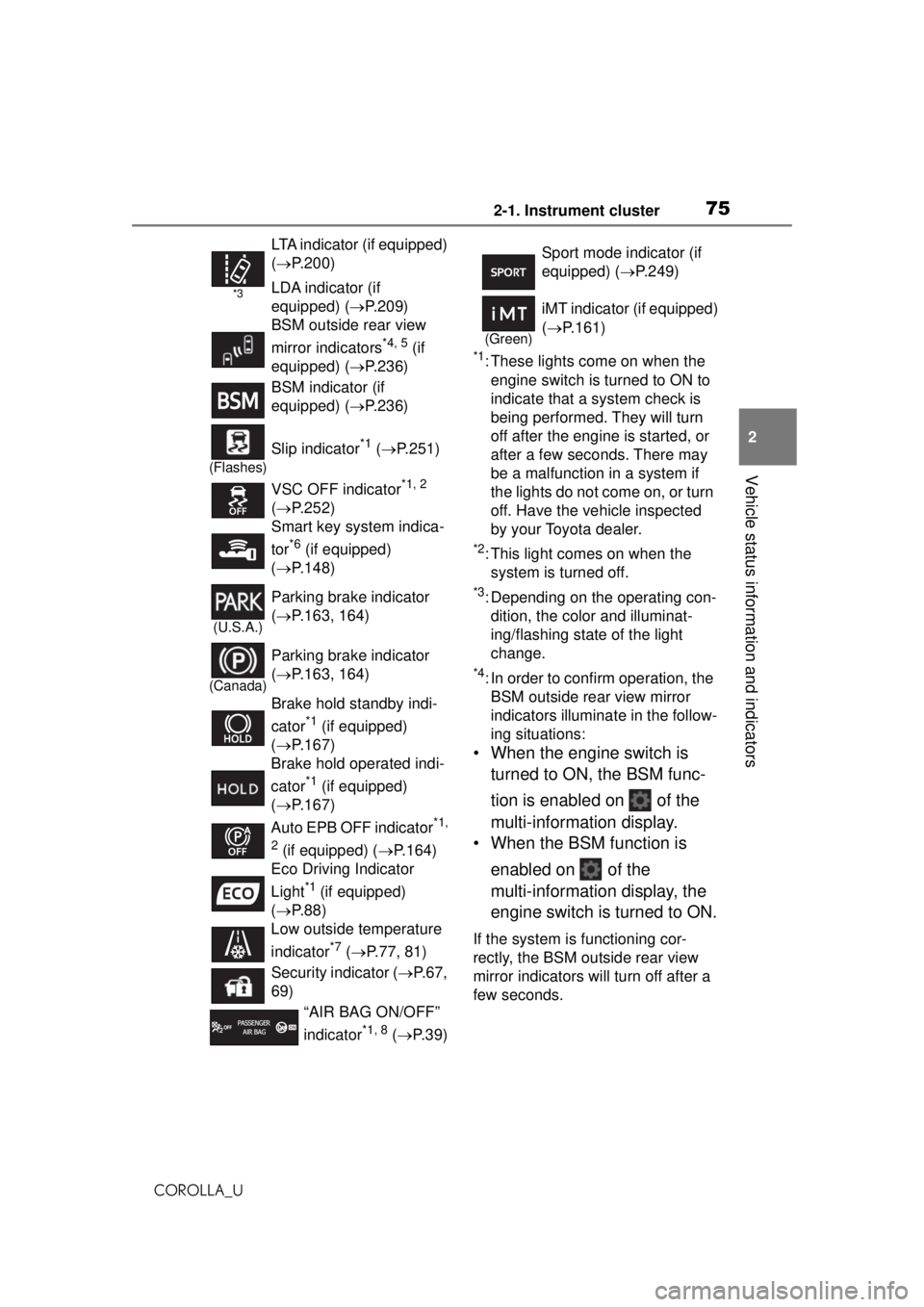
752-1. Instrument cluster
COROLLA_U
2
Vehicle status information and indicators
*1: These lights come on when the engine switch is turned to ON to
indicate that a system check is
being performed. They will turn
off after the engine is started, or
after a few sec onds. There may
be a malfunction in a system if
the lights do not come on, or turn
off. Have the vehicle inspected
by your Toyota dealer.
*2: This light comes on when the system is turned off.
*3: Depending on the operating con-dition, the color and illuminat-
ing/flashing state of the light
change.
*4: In order to confirm operation, the BSM outside rear view mirror
indicators illumina te in the follow-
ing situations:
• When the engine switch is
turned to ON, the BSM func-
tion is enabled on of the
multi-information display.
• When the BSM function is
enabled on of the
multi-information display, the
engine switch is turned to ON.
If the system is functioning cor-
rectly, the BSM outside rear view
mirror indicators will turn off after a
few seconds.
*3
LTA indicator (if equipped)
( P.200)
LDA indicator (if
equipped) ( P.209)
BSM outside rear view
mirror indicators
*4, 5 (if
equipped) ( P.236)
BSM indicator (if
equipped) ( P.236)
(Flashes)
Slip indicator*1 ( P.251)
VSC OFF indicator
*1, 2
( P.252)
Smart key system indica-
tor
*6 (if equipped)
( P.148)
(U.S.A.)
Parking brake indicator
( P.163, 164)
(Canada)
Parking brake indicator
( P.163, 164)
Brake hold standby indi-
cator
*1 (if equipped)
( P.167)
Brake hold operated indi-
cator
*1 (if equipped)
( P.167)
Auto EPB OFF indicator
*1,
2
(if equipped) ( P.164)
Eco Driving Indicator
Light
*1 (if equipped)
( P.88)
Low outside temperature
indicator
*7 ( P.77, 81)
Security indicator ( P.67,
69)
“AIR BAG ON/OFF”
indicator
*1, 8 ( P. 3 9 )
Sport mode indicator (if
equipped) ( P.249)
(Green)
iMT indicator (if equipped)
( P.161)
Page 135 of 588

1354-1. Before driving
COROLLA_U
4
Driving
4 Slowly release the brake
pedal.
5 Lock the door, making sure
that you have the key on your
person.
If parking on a hill, block the wheels
as needed.
Manual transmission
1 While depressing the clutch
pedal, depress the brake
pedal.
2 Set the parking brake.
( P.163, 164)
Check that the parking brake indi-
cator is illuminated.
3Shift the shift lever to N.
( P.160)
If parking on a hill, shift the shift
lever to 1 or R and block the wheels
as needed.
4Vehicles without a smart key
system: Turn the engine
switch to OFF to stop the
engine.
Vehicles with a smart key
system: Press the engine
switch to stop the engine.
5 Slowly release the brake
pedal.
6 Lock the door, making sure
that you have the key on your
person.
■Starting off on a steep
uphill
Continuously variable trans-
mission
1 Make sure that the parking
brake is set and shift the shift
lever to D.
Hill-start assist control will operate.
( P.251)
2 Gently depress the accelera-
tor pedal.
3 Release the parking brake.
Manual transmission
1 Make sure that the parking
brake is set and shift the shift
lever to 1.
Hill-start assist control will operate.
( P.251)
2 Lightly depress the accelera-
tor pedal at the same time as
gradually releasing the clutch
pedal.
3 Release the parking brake.
■Driving in the rain
●Drive carefully when it is raining,
because visibility will be reduced,
the windows may become
fogged-up, and the road will be
slippery.
●Drive carefully when it starts to
rain, because the road surface will
be especially slippery.
●Refrain from high speeds when
driving on an expressway in the
rain, because there may be a
layer of water between the tires
and the road surface, preventing
the steering and brakes from
operating properly.
Page 137 of 588

1374-1. Before driving
COROLLA_U
4
Driving
WARNING
■When driving the vehicle
●Do not drive if you are unfamil-
iar with the location of the brake
and accelerator pedals to avoid
depressing the wrong pedal.
• Accidentally depressing the accelerator pedal instead of the
brake pedal will result in sudden
acceleration that may lead to an
accident.
• When backing up, you may twist your body around, leading to a
difficulty in operating the pedals.
Make sure to operate the pedals
properly.
• Make sure to keep a correct driving posture even when mov-
ing the vehicle only slightly. This
allows you to depress the brake
and accelerator pedals properly.
• Depress the brake pedal using your right foot. Depressing the
brake pedal using your left foot
may delay response in an emer-
gency, resulting in an accident.
●Do not drive the vehicle over or
stop the vehicle near flammable
materials.
The exhaust system and
exhaust gases can be
extremely hot. These hot parts
may cause a fire if there is any
flammable material nearby.
●During normal driving, do not
turn off the engine. Turning the
engine off while driving will not
cause loss of steering or brak-
ing control, but the power assist
to these systems will be lost.
This will make it more difficult to
steer and brake, so you should
pull over and stop the vehicle as
soon as it is safe to do so.
However, in the event of an
emergency, such as if it
becomes impossible to stop the
vehicle in the normal way:
P.472
●Use engine braking (shift posi-
tion B*1 or downshift*2, 3) to
maintain a safe speed when
driving down a steep hill.
Using the brakes continuously
may cause the brakes to over-
heat and lose effectiveness.
(
P.153, 155, 160)
*1: Vehicles with a continuously
variable transmission (without
paddle shift switches)
*2: Vehicles with a continuously variable transmission (with
paddle shift switches)
*3: Vehicles with a manual trans-mission
●Do not adjust the positions of
the steering wheel, the seat, or
the inside or outside rear view
mirrors while driving.
Doing so may resu lt in a loss of
vehicle control.
●Always check that all passen-
gers’ arms, heads or other parts
of their body are not outside the
vehicle.
Page 138 of 588

1384-1. Before driving
COROLLA_U
WARNING
●Do not drive in excess of the
speed limit. Even if the legal
speed limit permits it, do not
drive over 85 mph (140 km/h)
unless your vehicle has
high-speed capability tires. Driv-
ing over 85 mph (140 km/h)
may result in tire failure, loss of
control and possible injury. Be
sure to consult a tire dealer to
determine whether the tires on
your vehicle are high-speed
capability tires or not before
driving at such speeds.
■When driving on slippery
road surfaces
●Sudden braking, acceleration
and steering may cause tire
slippage and reduce your ability
to control the vehicle.
●Sudden acceleration, engine
braking due to shifting, or
changes in engine speed could
cause the vehicle to skid.
●After driving through a puddle,
lightly depress the brake pedal
to make sure that the brakes
are functioning properly. Wet
brake pads may prevent the
brakes from functioning prop-
erly. If the brakes on only one
side are wet and not functioning
properly, steering control may
be affected.
■When shifting the shift lever
●Vehicles with a continuously
variable transmission: Do not let
the vehicle roll backward while a
forward driving position is
selected, or ro ll forward while
the shift lever is in R.
Doing so may cause the engine
to stall or lead to poor brake and
steering performance, resulting
in an accident or damage to the
vehicle.
●Vehicles with a continuously
variable transmission: Do not
shift the shift lever to P while the
vehicle is moving.
Doing so can damage the trans-
mission and may result in a loss
of vehicle control.
●Do not shift the shift lever to R
while the vehicle is moving for-
ward.
Doing so can damage the trans-
mission and may result in a loss
of vehicle control.
●Do not shift the shift lever to a
driving position while the vehicle
is moving backward.
Doing so can damage the trans-
mission and may result in a loss
of vehicle control.
●Moving the shift lever to N while
the vehicle is moving will disen-
gage the engine from the trans-
mission. Engine braking is not
available when N is selected.
●Vehicles with a continuously
variable transmission: Be care-
ful not to shift the shift lever with
the accelerator pedal
depressed. Shifting the shift
lever to any positions other than
P or N may lead to unexpected
rapid acceleration of the vehicle
that may cause an accident and
result in death or serious injury.
■If you hear a squealing or
scraping noise (brake pad
wear indicators)
Have the brake pads checked and
replaced by your Toyota dealer as
soon as possible.
Rotor damage may result if the
pads are not replaced when
needed.
It is dangerous to drive the vehicle
when the wear limits of the brake
pads and/or those of the brake
discs are exceeded.
Page 147 of 588
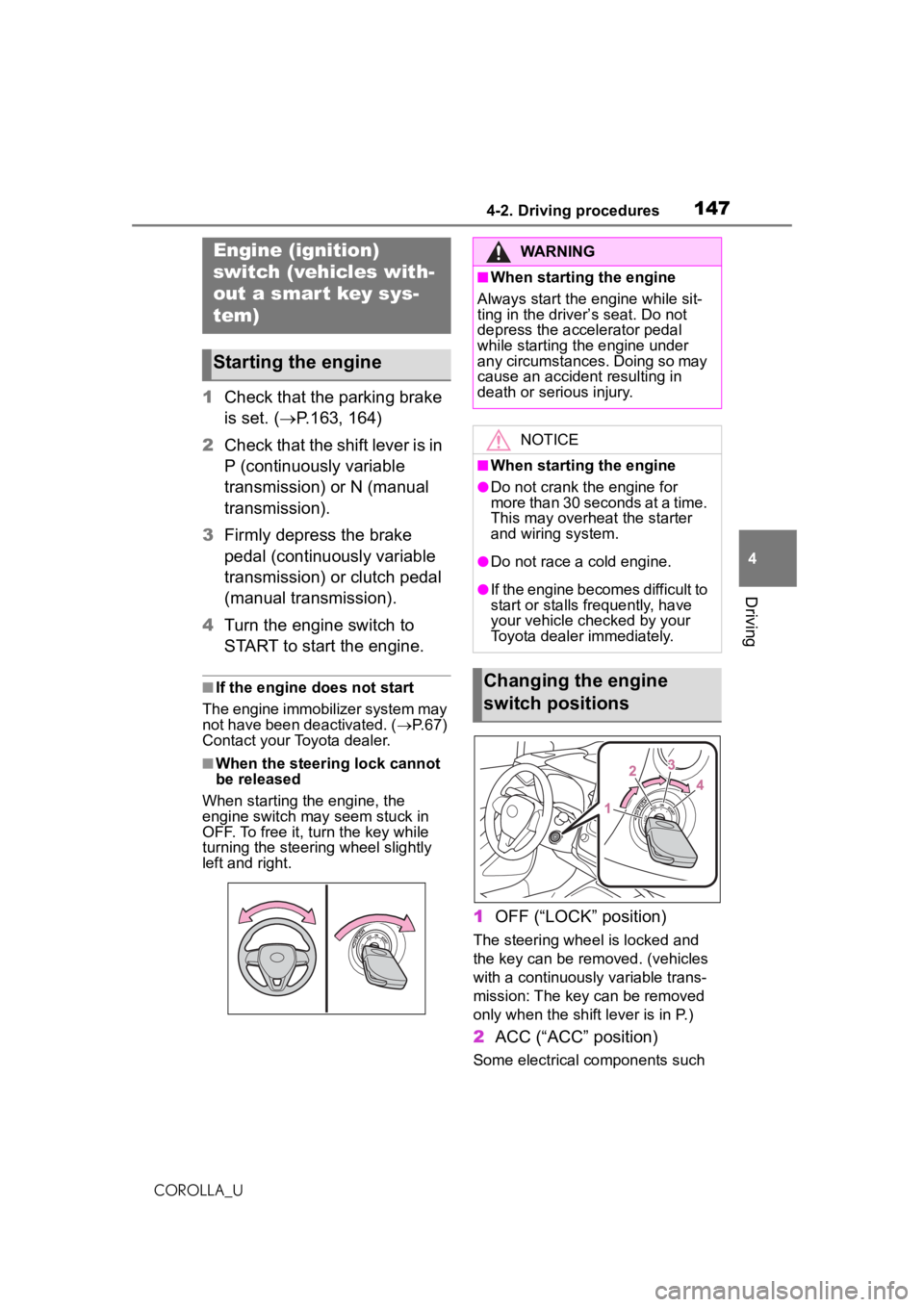
1474-2. Driving procedures
COROLLA_U
4
Driving
4-2.Driving procedures
1 Check that the parking brake
is set. ( P.163, 164)
2 Check that the shift lever is in
P (continuously variable
transmission) or N (manual
transmission).
3 Firmly depress the brake
pedal (continuously variable
transmission) or clutch pedal
(manual transmission).
4 Turn the engine switch to
START to start the engine.
■If the engine does not start
The engine immobilizer system may
not have been deactivated. ( P.67)
Contact your Toyota dealer.
■When the steering lock cannot
be released
When starting the engine, the
engine switch may seem stuck in
OFF. To free it, turn the key while
turning the steering wheel slightly
left and right.
1 OFF (“LOCK” position)
The steering wheel is locked and
the key can be removed. (vehicles
with a continuously variable trans-
mission: The key can be removed
only when the shift lever is in P.)
2ACC (“ACC” position)
Some electrical components such
Engine (ignition)
switch (vehicles with-
out a smart key sys-
tem)
Starting the engine
WARNING
■When starting the engine
Always start the engine while sit-
ting in the driver’s seat. Do not
depress the accelerator pedal
while starting the engine under
any circumstances. Doing so may
cause an accident resulting in
death or serious injury.
NOTICE
■When starting the engine
●Do not crank the engine for
more than 30 seconds at a time.
This may overheat the starter
and wiring system.
●Do not race a cold engine.
●If the engine becomes difficult to
start or stalls frequently, have
your vehicle checked by your
Toyota dealer immediately.
Changing the engine
switch positions